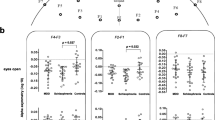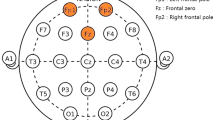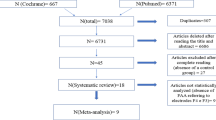Abstract
Background
A correlation between asymmetry in electroencephalographs (EEG) and depression has been demonstrated in many studies. To the best of our knowledge there are no studies including oldest old geriatric patients.
Objective
The objective of this study was to evaluate whether frontal and parietal alpha asymmetry can be used to differentiate between depressed and control patients in a cohort sample with a mean age of 80 years.
Material and methods
Differences in the EEG were investigated in 39 right-handed female geriatric patients (mean age 80 years) with respect to frontal alpha asymmetry (FAA) and parietal alpha asymmetry (PAA) in depression (n = 14), depression combined with anxiety (n = 11) and normal controls (n = 14) as assessed with the hospital anxiety and depression scale (HADS). Band power was calculated for alpha 1 (6.9–8.9 Hz), alpha 2 (8.9–10.9 Hz) and alpha 3 bands (10.9–12.9 Hz). Furthermore, correlations between frontal and parietal alpha asymmetry and the geriatric depression scale (GDS), the HADS and the mini mental state examination (MMSE) were calculated.
Results
A differentiation between the three groups was not possible with FAA and PAA. Significant correlations were found between PAA alpha 3 band and anxiety and depression.
Conclusion
The alpha asymmetry in EEG seemed to disappear with age. Correlations between PAA and anxiety and depression were found. The results are in line with the right (hemisphere) hemi-aging hypothesis.
Zusammenfassung
Hintergrund
Eine Korrelation zwischen einer Asymmetrie im Elektroenzephalogramm (EEG) und Depression konnte in vielen Studien bestätigt werden. Unserem Wissen nach gibt es keine Studien mit hochbetagten geriatrischen Patienten.
Ziel
Ziel der Arbeit ist die Analyse frontaler und parietaler Alpha-Asymmetrie hinsichtlich der Unterscheidungsfähigkeit zwischen Depressiven und Kontrollpersonen in einer Stichprobe von über 80-jährigen Patienten.
Material und Methoden
EEG-Unterschiede wurden bei 39 rechtshändigen weiblichen geriatrischen Patienten (Durchschnittsalter: 80 Jahre) bezüglich frontaler Alpha-Asymmetrie (FAA) und parietaler Alpha-Asymmetrie (PAA) bei depressiven (n = 14), ängstlich-depressiven (n = 11), und Kontrollpersonen (n = 14) untersucht. Für die Erfassung ängstlicher und depressiver Symptome wurde die Hospital Anxiety and Depression Scale (HADS) verwendet. Der Leistungspegel wurde für Alpha 1 (6.9–8.9 Hz), Alpha 2 (8.9–10.9 Hz) und Alpha 3 (10.9–12.9 Hz) berechnet. Des Weiteren wurden Korrelationen zwischen frontaler und parietaler Alpha-Asymmetrie und Geriatric Depression Scale (GDS), Hospital Anxiety and Depression Scale (HADS) sowie Mini Mental State Examination (MMSE) berechnet.
Ergebnisse
FAA und parietale Alpha Asymmetrie konnten nicht zwischen den drei Gruppen unterscheiden. Allerdings fanden wir eine Korrelation zwischen PAA Alpha 3 sowie Angst und Depression.
Diskussion
Die EEG Alpha Asymmetrie scheint mit dem Alter zu verschwinden. Korrelationen zwischen PAA und Angst und Depression konnten gefunden werden. Die Ergebnisse bestätigen die Hypothese zur rechts-hemispherischen Alterung (right hemi-aging hypothesis).

Similar content being viewed by others
References
Allen JJ, Urry HL, Hitt SK, Coan JA (2004) The stability of resting frontal electroencephalographic asymmetry in depression. Psychophysiology 41:269–280
Berlingeri M, Danelli L, Bottini G, Sberna M, Paulesu E (2013) Reassessing the HAROLD model: is the hemispheric asymmetry reduction in older adults a special case of compensatory-related utilisation of neural circuits? Exp Brain Res 224:393–410
Blackhart GC, Minnix JA, Kline JP (2006) Can EEG asymmetry patterns predict future development of anxiety and depression? A preliminary study. Biol Psychol 72:46–50
Bruder GE, Fong R, Tenke CE, Leite P, Towey JP, Stewart JE, McGrath PJ, Quitkin FM (1997) Regional brain asymmetries in major depression with or without an anxiety disorder: A quantitative electroencephalographic study. Biol Psychiatry 41:939–948
Byers AL, Yaffe K, Covinsky KE, Friedman MB, Bruce ML (2010) High occurrence of mood and anxiety disorders among older adults: The National Comorbidity Survey Replication. Arch Gen Psychiatry 67:489–496
Cabeza R (2002) Hemispheric asymmetry reduction in older adults: the HAROLD model. Psychol Aging 17:85–100
Carvalho A, Moraes H, Silveira H, Ribeiro P, Piedade RAM, Deslandes AC, Laks J, Versiani M (2011) EEG frontal asymmetry in the depressed and remitted elderly: Is it related to the trait or to the state of depression? J Affect Disord 129:143–148
Chandler MJ, Lacritz LH, Hynan LS, Barnard HD, Allen G, Deschner M, Weiner MF, Cullum CM (2005) A total score for the CERAD neuropsychological battery. Neurology. doi:10.1212/01.wnl.0000167607.63000.38
Cooper NR, Croft RJ, Dominey SJ, Burgess AP, Gruzelier JH (2003) Paradox lost? Exploring the role of alpha oscillations during externally vs. internally directed attention and the implications for idling and inhibition hypotheses. Int J Psychophysiol 47:65–74
Deslandes AC, de Moraes H, Pompeu FA, Ribeiro P, Cagy M, Capitao C, Alves H, Piedade RA, Laks J (2008) Electroencephalographic frontal asymmetry and depressive symptoms in the elderly. Biol Psychol 79:317–322
Dolcos F, Rice HJ, Cabeza R (2002) Hemispheric asymmetry and aging: right hemisphere decline or asymmetry reduction. Neurosci Biobehav Rev 26:819–825
Folstein MF, Folstein SE, McHugh PR (1975) “Mini-mental state” : A practical method for grading the cognitive state of patients for the clinician. J Psychiatr Res 12:189–198
Gianotti LR, Kunig G, Lehmann D, Faber PL, Pascual-Marqui RD, Kochi K, Schreiter-Gasser U (2007) Correlation between disease severity and brain electric LORETA tomography in Alzheimer’s disease. Clin Neurophysiol 118:186–196
Gold C, Fachner J, Erkkila J (2013) Validity and reliability of electroencephalographic frontal alpha asymmetry and frontal midline theta as biomarkers for depression. Scand J Psychol 54:118–126
Henriques JB, Davidson RJ (1990) Regional brain electrical asymmetries discriminate between previously depressed and healthy control subjects. J Abnorm Psychol 99:22–31
Henriques JB, Davidson RJ (1991) Left frontal hypoactivation in depression. J Abnorm Psychol 100:535–545
Kemp AH, Griffiths K, Felmingham KL, Shankman SA, Drinkenburg W, Arns M, Clark CR, Bryant RA (2010) Disorder specificity despite comorbidity: resting EEG alpha asymmetry in major depressive disorder and post-traumatic stress disorder. Biol Psychol 85:350–354
Kentgen LM, Tenke CE, Pine DS, Fong R, Klein RG, Bruder GE (2000) Electroencephalographic asymmetries in adolescents with major depression: influence of comorbidity with anxiety disorders. J Abnorm Psychol 109:797–802
Klimesch W, Sauseng P, Hanslmayr S (2007) EEG alpha oscillations: the inhibition-timing hypothesis. Brain Res Rev 53:63–88
Leiser SC, Dunlop J, Bowlby MR, Devilbiss DM (2011) Aligning strategies for using EEG as a surrogate biomarker: a review of preclinical and clinical research. Biochem Pharmacol 81:1408–1421
Mathersul D, Williams LM, Hopkinson PJ, Kemp AH (2008) Investigating models of affect: relationships among EEG alpha asymmetry, depression, and anxiety. Emotion 8:560–572
Mathewson KJ, Hashemi A, Sheng B, Sekuler AB, Bennett PJ, Schmidt LA (2015) Regional electroencephalogram (EEG) alpha power and asymmetry in older adults: a study of short-term test-retest reliability. Front Aging Neurosci 7:177
Moretti DV, Frisoni GB, Fracassi C, Pievani M, Geroldi C, Binetti G, Rossini PM, Zanetti O (2011) MCI patients’ EEGs show group differences between those who progress and those who do not progress to AD. Neurobiol Aging 32:563–571
Moretti DV, Paternicò D, Binetti G, Zanetti O, Frisoni GB (2012) EEG markers are associated to gray matter changes in thalamus and basal ganglia in subjects with mild cognitive impairment. Neuroimage 60:489–496
Morris JC, Mosh RC, Rogers H, Fillenbaum G, Heyman A (1988) Consortium to establish a registry for alzheimer’s disease. Psychopharmacol Bull 24:641–652
Quinn CR, Rennie CJ, Harris AWF, Kemp AH (2013) The impact of melancholia versus non-melancholia on resting-state, EEG alpha asymmetry: Electrophysiological evidence for depression heterogeneity. Psychiatry Res. doi:10.1016/j.psychres.2013.12.049
Schaffer CE, Davidson RJ, Saron C (1983) Frontal and parietal electroencephalogram asymmetry in depressed and nondepressed subjects. Biol Psychiatry 18:753–762
Segrave RA, Cooper NR, Thomson RH, Croft RJ, Sheppard DM, Fitzgerald PB (2011) Individualized alpha activity and frontal asymmetry in major depression. Clin EEG Neurosci 42:45–52
Sheikh JI, Yesavage JA (1986) Geriatric Depression Scale (GDS). Recent evidence and development of a shorter version. In: Brink TL (ed) Clinical Gerontology: a Guide to Assessment and Intervention. Haworth Press, NY, pp 165–173
Stewart JL, Bismark AW, Towers DN, Coan JA, Allen JJ (2010) Resting frontal EEG asymmetry as an endophenotype for depression risk: sex-specific patterns of frontal brain asymmetry. J Abnorm Psychol 119:502–512
Stewart JL, Towers DN, Coan JA, Allen JJ (2011) The oft-neglected role of parietal EEG asymmetry and risk for major depressive disorder. Psychophysiology 48:82–95
Zigmond AS, Snaith RP (1983) The hospital anxiety and depression scale. Acta Psychiatr Scand 67:361–370
Author information
Authors and Affiliations
Corresponding author
Ethics declarations
Conflict of interests
A. K. Kaiser, M. Doppelmayr and B. Iglseder state that there are no conflicts of interest.
The study was approved be the local ethics committee. Written informed consent was obtained from all participants included in the study.
Rights and permissions
About this article
Cite this article
Kaiser, A.K., Doppelmayr, M. & Iglseder, B. Electroencephalogram alpha asymmetry in geriatric depression. Z Gerontol Geriat 51, 200–205 (2018). https://doi.org/10.1007/s00391-016-1108-z
Received:
Revised:
Accepted:
Published:
Issue Date:
DOI: https://doi.org/10.1007/s00391-016-1108-z




